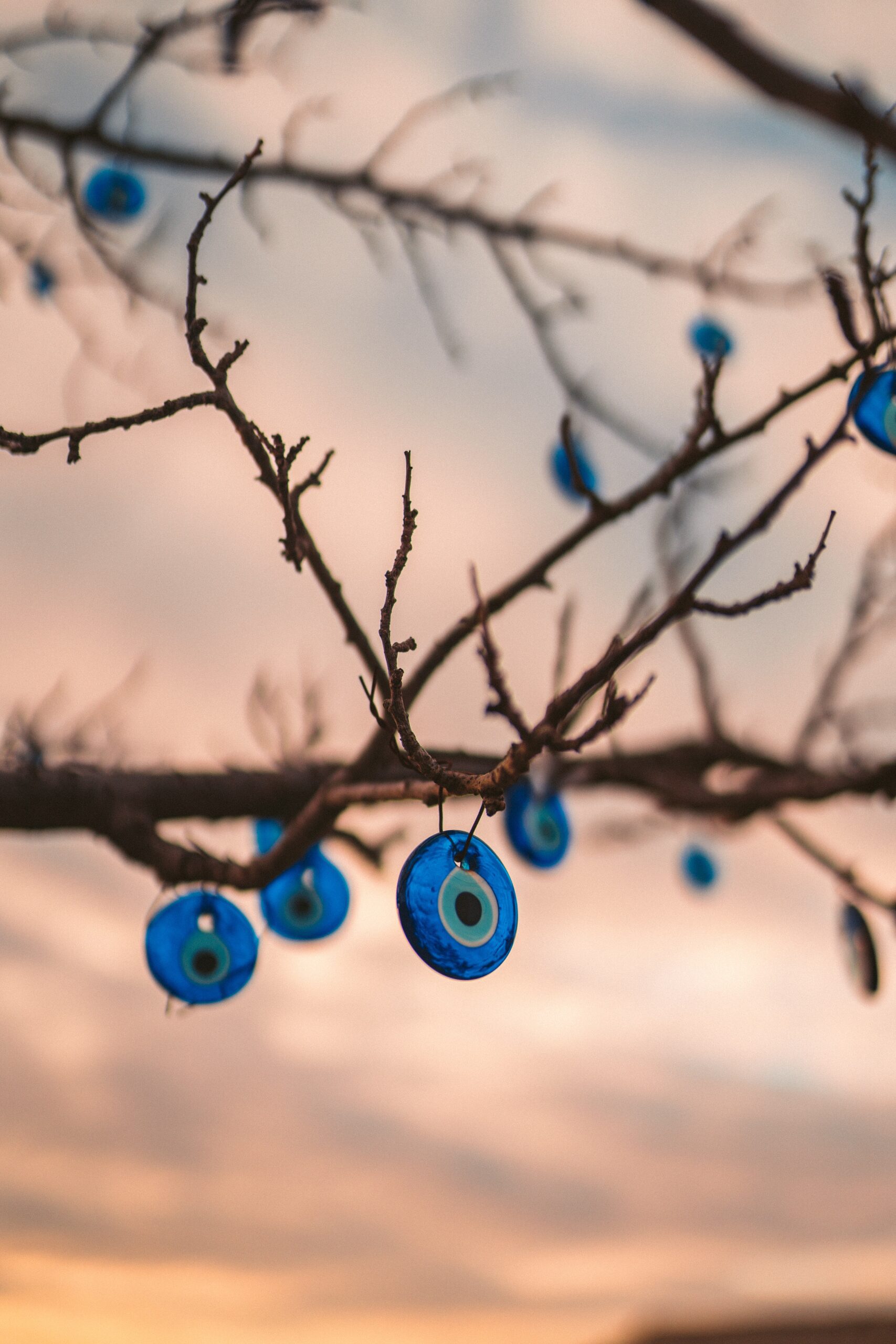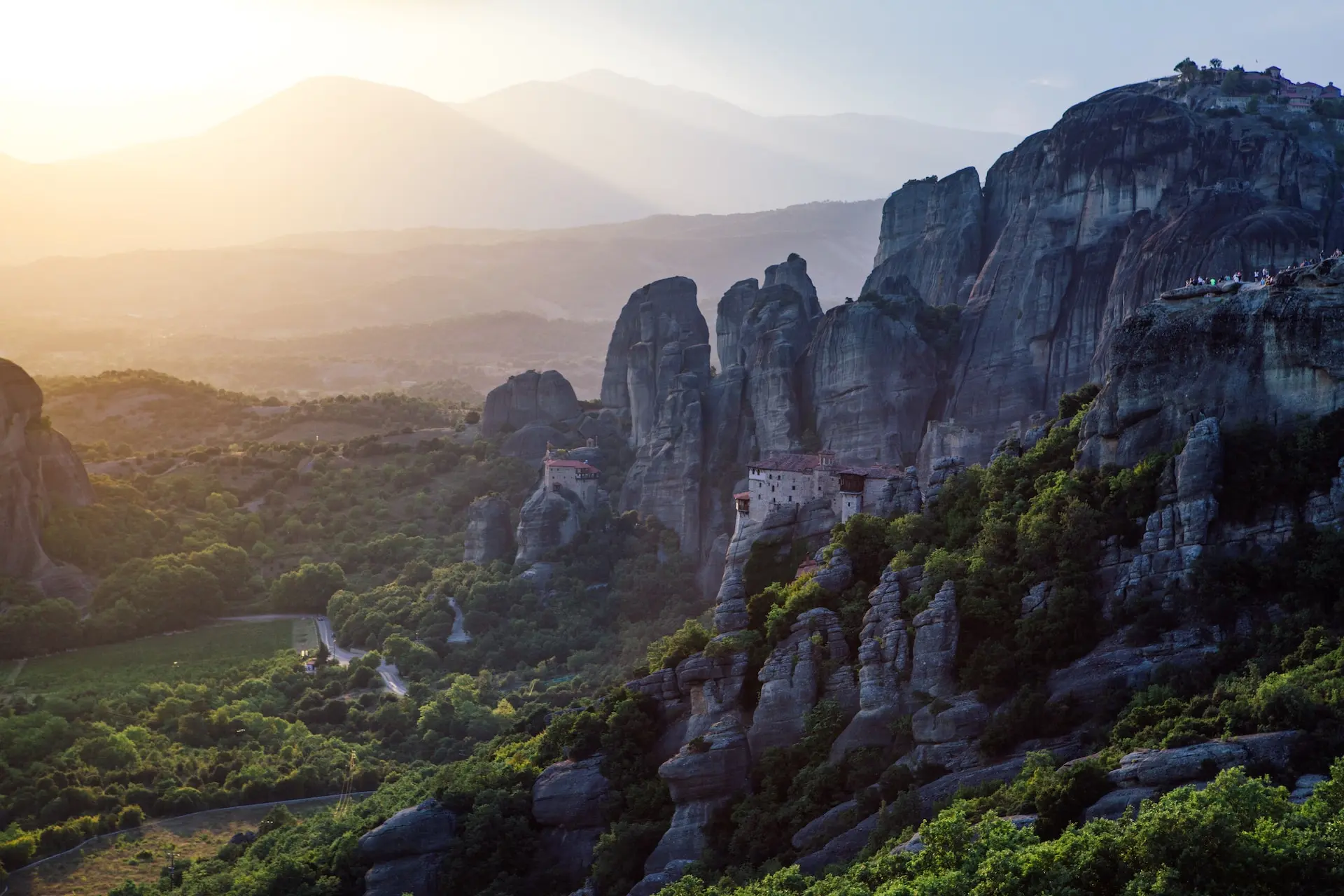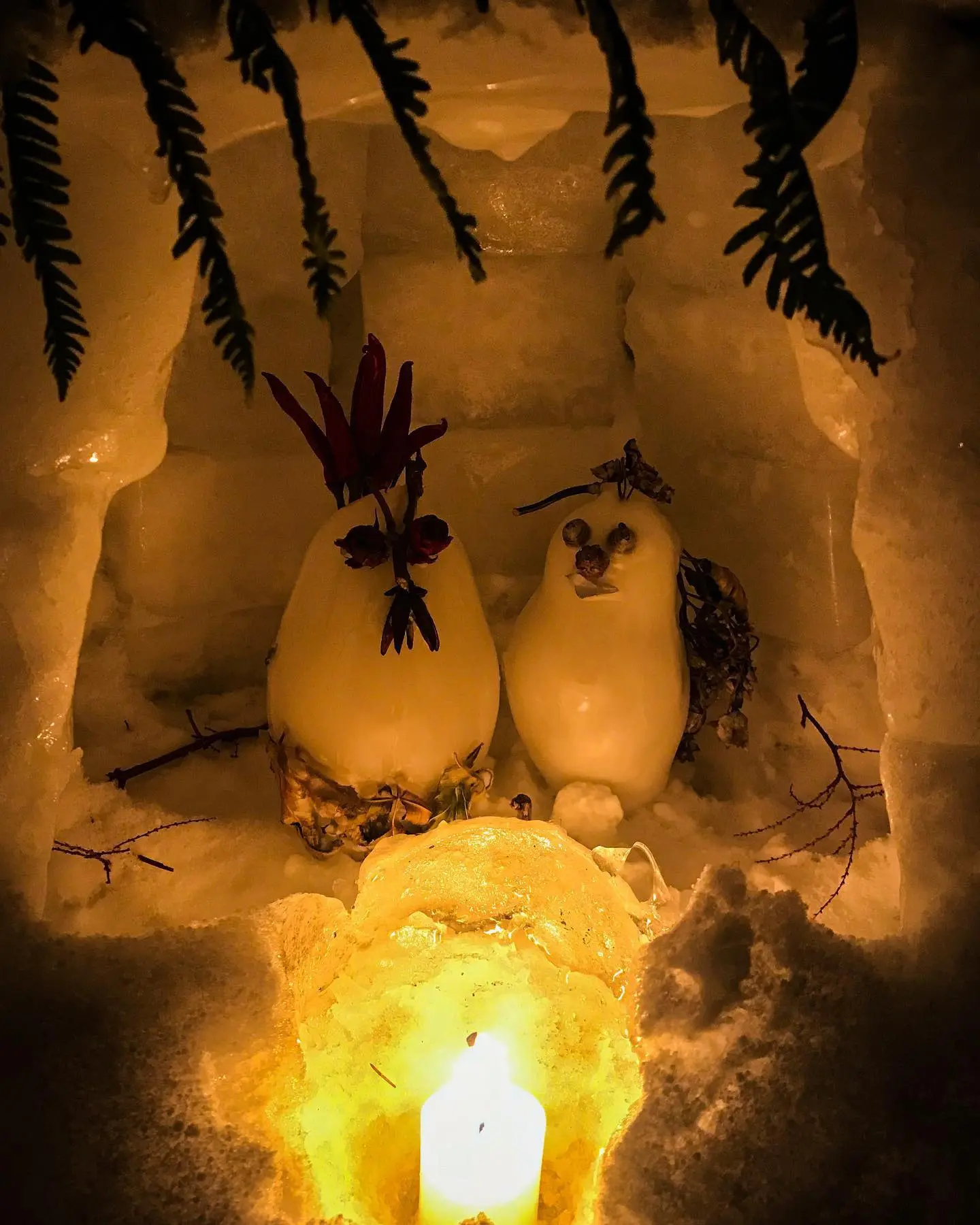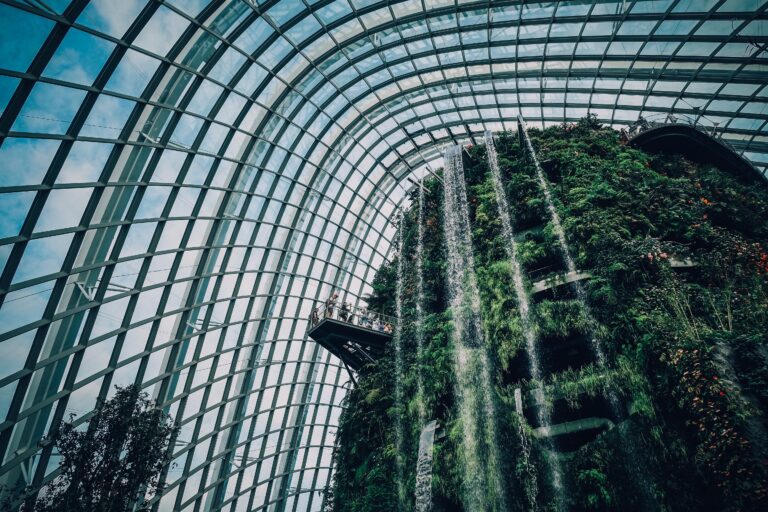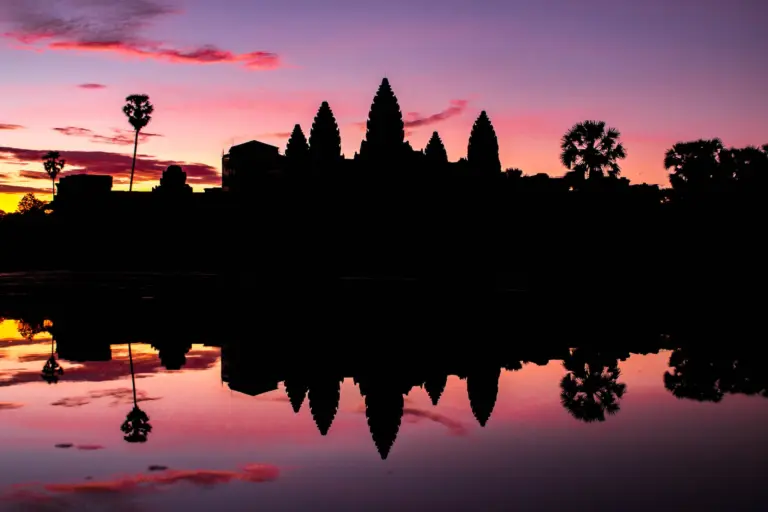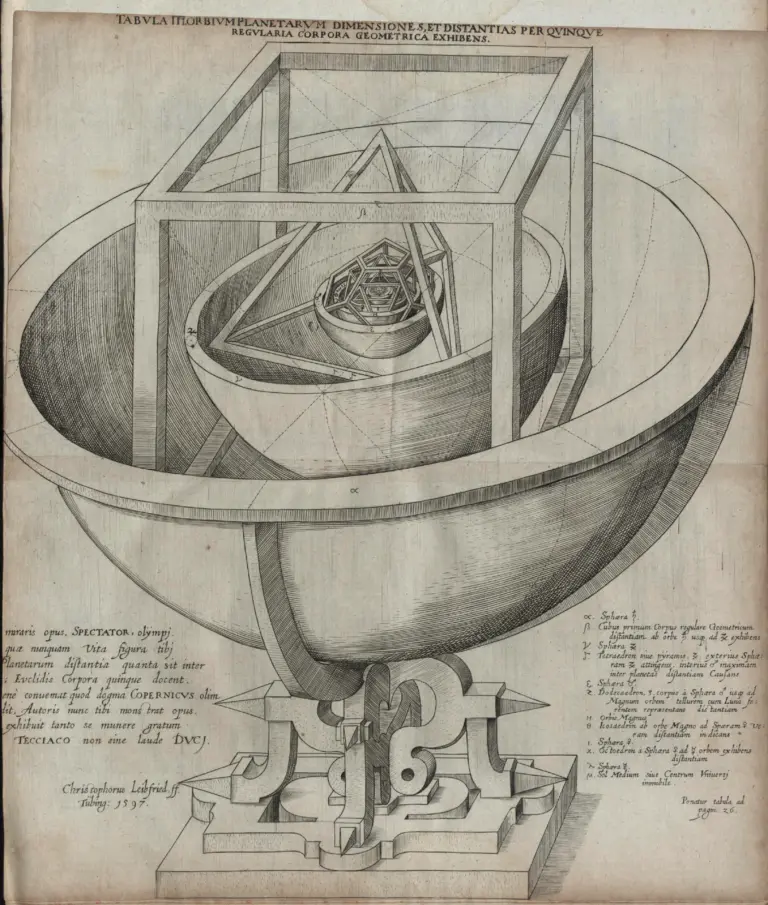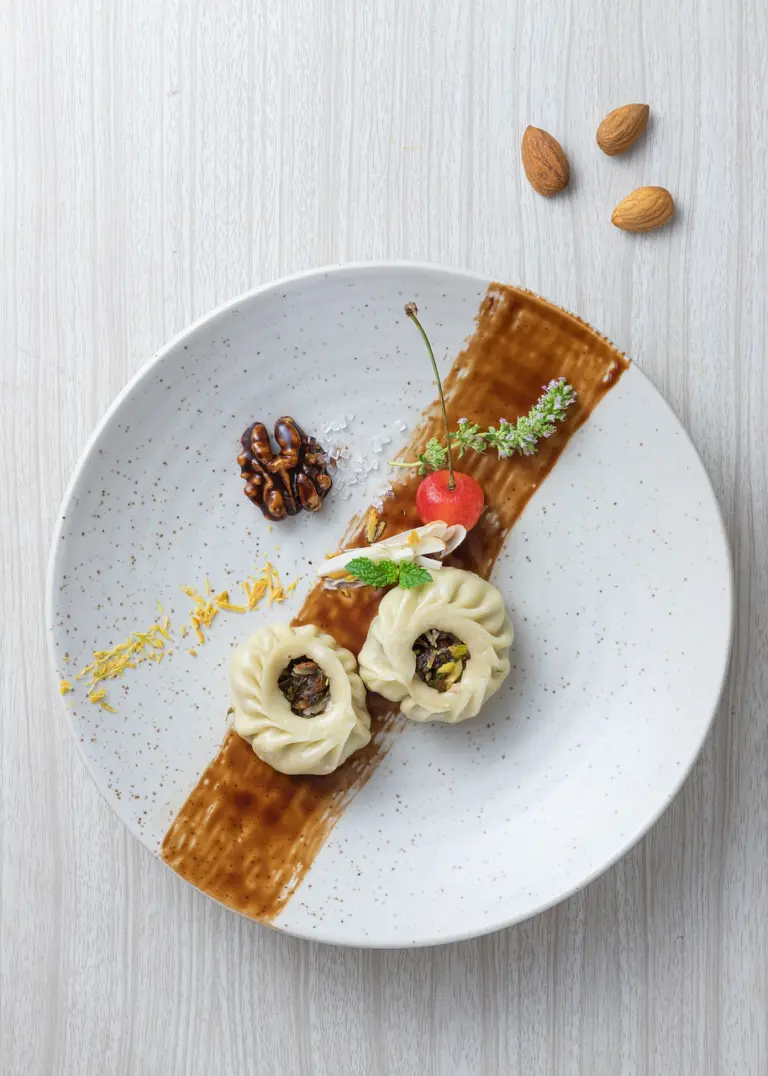Imagine standing in the heart of an age-old city, surrounded by stone faces gazing down at you, their serene expressions exuding an air of silent wisdom. That’s Bayon for you.
Bayon Temple was the first temple we encountered during our time cycling around Angkor. It was so magnificent that we ended up going back again on the third day and were still mindblown even after visiting so many other temples. Bayon Temple can easily vie for the title of best temple in Cambodia.
You can find all you need to know about Bayon in this article. I cover not only the basics but the history, symbolisms, meanings as well as some secrets that might intrigue even the history-buffs!
Table of Contents
ToggleWhere to Stay in Siem Reap
Siem Reap is a very small town and you can find most places close to each other and all within 15 – 30 minutes from Angkor Archaelogical Park. Here are some of my recommendations:
Best Hotels in Siem Reap
- Han & Daniel Villa Boutique – this is where we personally stayed and what can I say except that it was a blast! The location is conveniently located near most of the sites that we went to around town such as the Phare Circus and the e-bike rental shop. The rooms were spacious and a good bathroom. The beds were great too. They had parking spaces for our bikes with an in-house restaurant for whenever we were lazy to get food outside. Daniel kindly helped us with a lot of stuff too such as an airport pick-up, airport drop-off, and helping us get tickets to Angkor Archaeological Park. The best part was the pool which we were taking a dip in every day!
- Two Seasons Siem Reap Hotel – offers an outdoor pool, free private parking, and a range of services including room service, a 24-hour front desk, and free WiFi. The rooms are air-conditioned, with a desk, flat-screen TV, and private bathroom.
- Damrei Residence & Spa – offer a flat-screen TV, and a seating area. You can enjoy the garden or city views while relaxing with a cup of tea. All rooms have a private bathroom with bathrobes, slippers, and complimentary toiletries.
- Onederz Hostel Siem Reap – a clean, comfortable, and friendly place to stay. With its well-designed layout and premium amenities, including three swimming pools, this hostel offers a high-quality experience.
- Mad Monkey Siem Reap – offers a range of room options, a fantastic pool, and an incredible bar and restaurant serving both local and Western cuisine. At Mad Monkey, you’ll have the opportunity to connect with fellow fun-loving travelers from all around the globe.
- Lub d Cambodia Siem Reap – featuring a Khmer-chic inspired design, Lub d Siem Reap boasts a swimming pool with a swim-up pool bar, inviting lounging areas, and a games area with a pool table and Pacman arcade game. You can indulge in all-day breakfast, expertly brewed coffee at The PumpHouse, and quick snacks from the Grab & Go counter.
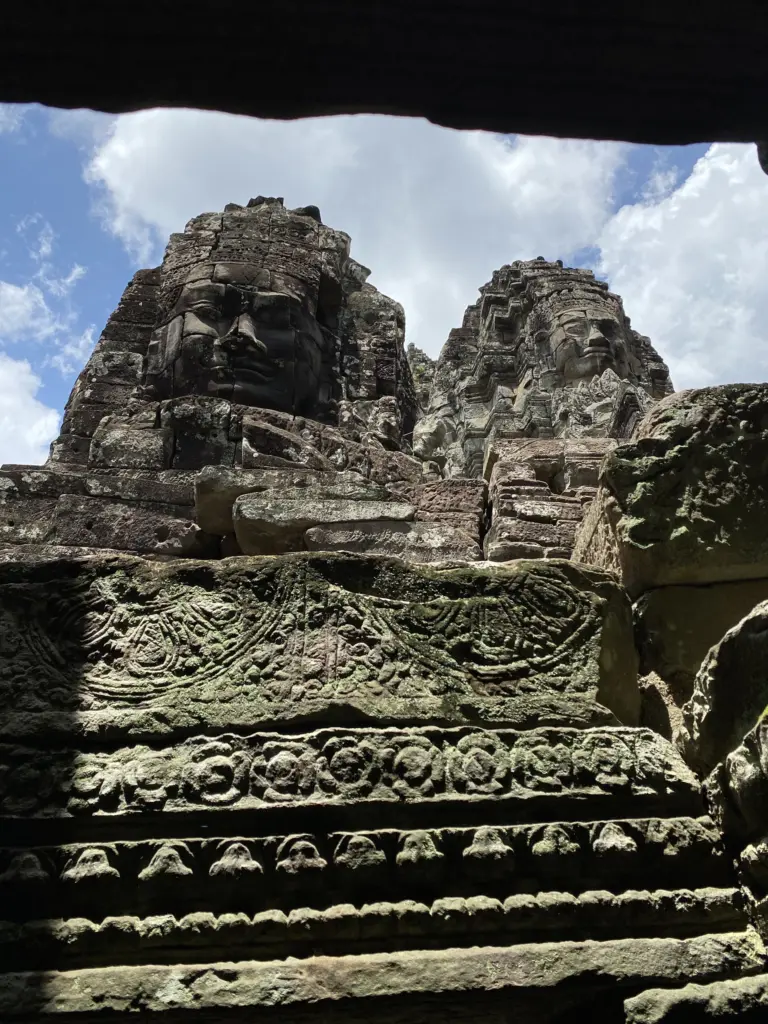
What to Know About Bayon Temple
1. What is Bayon Temple?
The Bayon Temple is a richly decorated and profoundly symbolic Khmer temple known for its massive stone faces, Bayon is the epitome of the high classical style of Khmer architecture.
While the temple’s design follows a centralised plan, it’s also known for its complexity and maze-like layout, with numerous narrow corridors and small sanctuaries adding to the sense of exploration. You’ll most likely agree once you see it for yourself!
2. Where is Bayon Temple?
Bayon Temple is located in Cambodia’s Angkor Archaological Park, a major archaeological site in Southeast Asia. It’s in the heart of the ancient city of Angkor Thom which is just north of Siem Reap.
To give you an idea, it’s about 1.2 km (0.7 mi) from the south gate of Angkor Thom and approximately 7.7 km (5 mi) north of Siem Reap.
Location: Bayon Temple
Opening Hours: 7:30 AM – 5:30 PM
Pro-tips:
- Bayon Temple has numerous entrances and depending on which direction you enter, the experience is totally different! The first day we didn’t realize we entered from the back side, the third day we went back through the front and it was like a whole ‘nother temple!
- Bayon Temple is one of the best temples to practice photography composition, you can utilize the geometrical square framings, symmetrical shapes and abstract minimalism to create powerful photos.
- If you’re open to it, having a guide can be interesting as there are so many secrets around Bayon that we would have missed otherwise, including photo spots! In the end, we had to cut the tour short as we felt like we were being shepherded too much.

3. What is Special About Bayon Temple?
Bayon Temple has plenty of unique features that sets it apart from other temples within the Angkor complex. Here are three reasons why:
The Faces: Perhaps the most distinctive feature of Bayon Temple are the gigantic stone faces that stare down serenely from every angle.
The Bas-Reliefs: Bayon Temple’s outer gallery is adorned with extensive bas-reliefs depicting historical events and scenes from the everyday life of the Angkorian Khmer. Unlike earlier temples which mostly depicted Hindu stories, Bayon’s reliefs provide a insight into history, warfare, and the common people’s way of life.
The Architecture: Bayon marks the change from the classical style of Angkor Wat to a more complex architecture. Basically it’s the transition from what historians call Angkor Style and Bayon Style architecture.

4. Bayon Temple Size
The overall site of Bayon measures about 140 m (459 ft) by 160 m (525 ft). The central tower soars around 43 m (141 ft) into the sky.
The city of Angkor Thom, enclosed by square ramparts measuring approximately 3 km (1.86 mi) on each side, spans a total area of about 9 sq km (3.5 sq mi).
Meanwhile, the giant faces on Bayon’s towers are about 4 m (13 ft) each.
5. Bayon Temple Dress Code
While there aren’t specific dress codes strictly for the Bayon, it falls within the Angkor Archaeological Park, which does have guidelines in place.
The dress code at Bayon requests visitors to cover their shoulders and knees.
While it’s certainly possible to explore the temple wearing shorts, you won’t be allowed up the higher terraces so it’s best to stick to the guidelines.
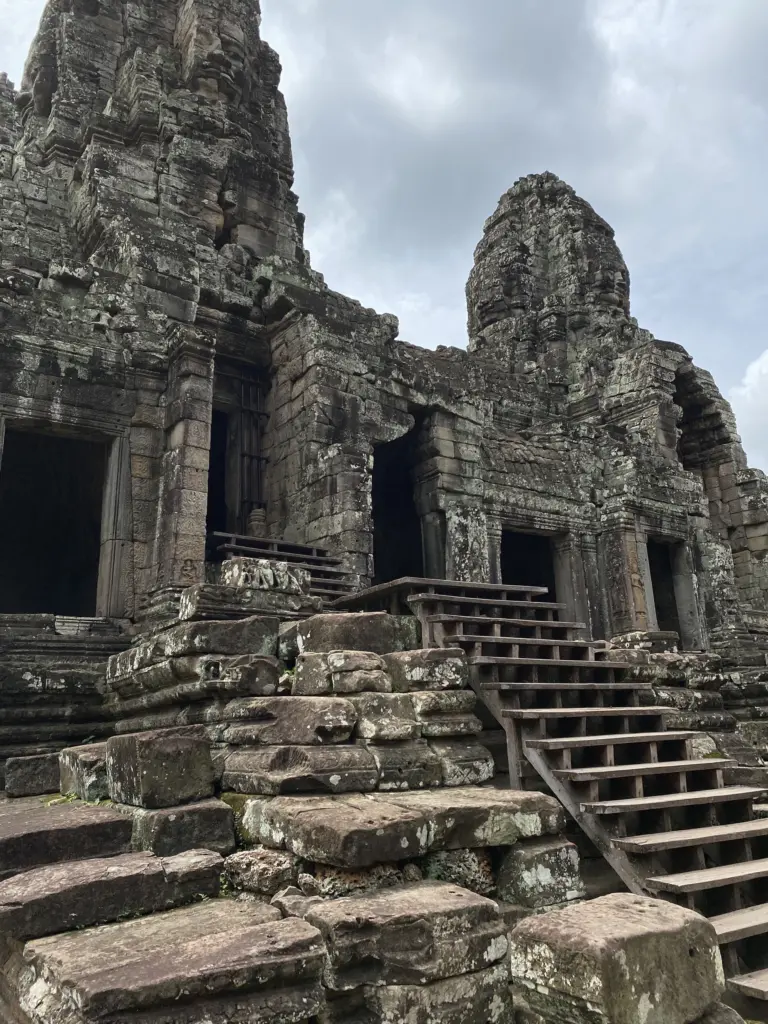
6. Bayon Temple Tours
There are several tours that include a visit to Bayon Temple as well as other nearby sites, you can find them here:
- Private Tour of Bayon, Angkor Wat and Angkor Thom
- Tour by Tuktuk of Bayon and Angkor Thom
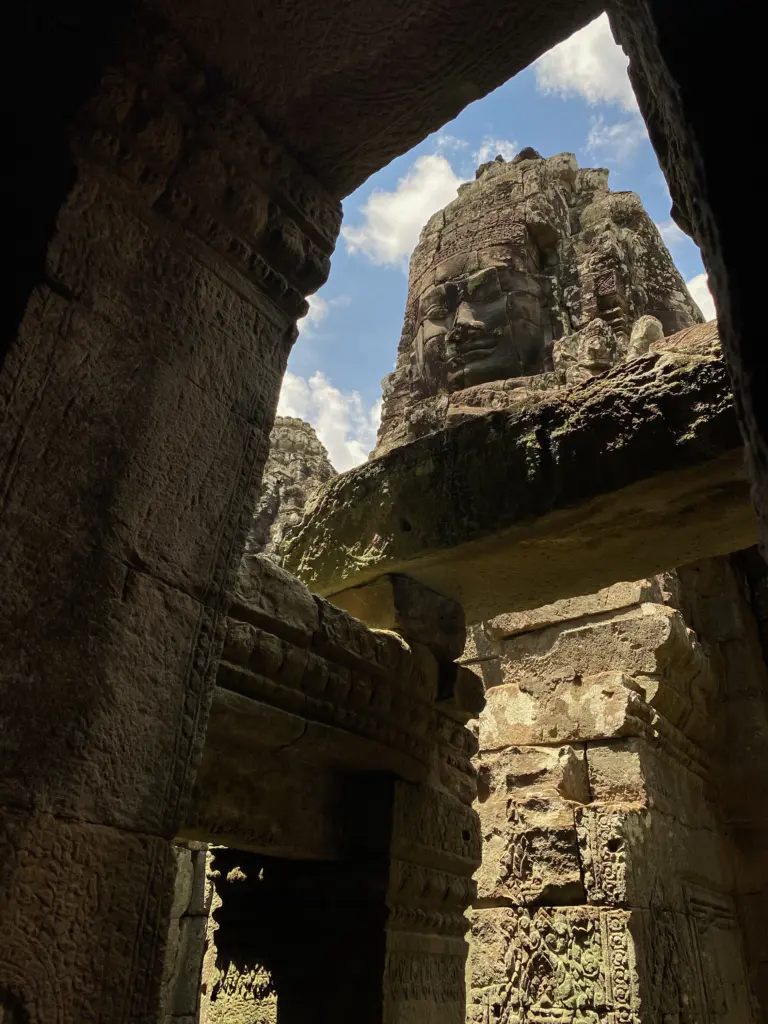
Bayon Temple History
7. Who Built Bayon Temple?
The Bayon Temple was built by King Jayavarman VII, often considered one of the greatest kings of the Khmer Empire.
Jayavarman VII ascended to the throne in a time of turmoil, after the Khmer Empire had been invaded by the Chams from what is now Vietnam. He managed to repel the invaders, and then embarked on a series of military campaigns to consolidate and expand his power. His military successes, however, were just the beginning.
He is the king responsible for the construction of not just Bayon Temple, but also many other important temples, including Ta Prohm and Preah Khan.
Beyond his architectural contributions, Jayavarman VII is also said to have built a network of hospitals across the empire.
A devout Mahayana Buddhist, his beliefs significantly influenced the religious direction of his kingdom, marking a shift from the primarily Hindu orientation of his predecessors. However, his approach to religion was inclusive, incorporating Hindu and local ancestral deities into his pantheon and demonstrating religious tolerance.
8. When was Bayon Temple Built?
The construction of Bayon Temple began towards the end of the 12th century. The exact year is not definitively known, but it’s generally agreed that construction started around 1181 AD, following Jayavarman VII’s victory over the Cham invaders.

9. Why was Bayon Temple Built?
Jayavarman VII was a king with a grand vision and even grander dreams. He decides to build a city, Angkor Thom, that would stand as a symbol of his Buddhist beliefs. At the center of this metropolis, he commissions the creation of a majestic temple, the Bayon, to serve as the state temple of his new capital.
Now, the king wanted this temple to be special, a sort of divine nexus connecting the spiritual and earthly realms. As such, he dedicated it to the Buddha, deviating from the Hindu tradition followed by his predecessors.
10. Bayon Temple Timeline
-
Late 12th century: Construction of the Bayon Temple began under the rule of King Jayavarman VII, following his victory against the Chams. It was initially built as a Mahayana Buddhist temple, serving as the state temple of Jayavarman VII.
-
Early 13th century: After King Jayavarman VII’s death, his son Indravarman II took the throne and made additions to the temple. During his reign, the temple underwent modifications, but it still remained a Buddhist place of worship.
-
Late 13th century: Jayavarman VIII, a Hindu, ascended to the throne and initiated widespread changes, resulting in many Buddhist images in Bayon being destroyed or modified into Hindu deities.
-
14th century: Towards the end of Jayavarman VIII’s reign, and especially after his death, there was a return to Buddhism (this time Theravada Buddhism), and many of the Hindu images were altered once again into Buddha images.
-
15th century onwards: Bayon was largely left to the ravages of time and the encroaching jungle, though some restoration and conservation work was performed.
-
20th – 21st century: The Ecole Francaise d’Extreme Orient (EFEO) took responsibility for the monument, and systematic restoration efforts were initiated. The restoration is ongoing, with the temple now a prominent tourist attraction and UNESCO World Heritage Site as part of the Angkor Archaeological Park.

Bayon Temple Architecture
11. What is Bayon Temple Made Out of?
The Bayon Temple, like most of the Angkor temples, was built using a type of sandstone known as “Angkor sandstone.” This material was sourced from the nearby quarries at the foothills of the sacred Phnom Kulen mountains, and it was highly favored due to its durability and the relative ease with which it could be carved.
Angkor sandstone is a warm, grayish-brown stone that beautifully takes on a golden hue under the Cambodian sun.
12. How was Bayon Temple Built?
Building the Bayon Temple was no small feat!
The construction method involved a combination of two techniques. The first was the corbelling technique, used to build the roofs of the inner galleries. This method involves overlapping stones to create a sort of arched structure, which is then capped with flat stones.
The second technique was post and lintel, a building method where vertical posts (pillars) are used to support lintels (horizontal beams). This technique was used to build doorways and windows throughout the temple.
To transport the massive sandstone blocks from the quarry to the construction site, the Khmer builders likely used a system of canals and roads. Elephants were probably used as the main source of power for moving these hefty stones.
Once the stones reached the site, they were carved and assembled into the structure of the temple. This didn’t involve any mortar. Instead, the stones were carefully cut and fitted together, almost like a giant 3D puzzle. The intricate bas-reliefs and iconic faces were then carved directly onto the stones.

13. Is Bayon Temple Bigger than Angkor Wat?
While the Bayon Temple is incredibly majestic on its own, in terms of physical size, it’s not larger than Angkor Wat. Angkor Wat is actually the largest religious monument in the world. Spanning over 402 acres, Angkor Wat is a colossal complex that’s surrounded by a wide moat and contains a multitude of structures, corridors, and courtyards.
Bayon Temple Facts
14. What is the Original Name of Bayon?
The term “Bayon” is simply the modern name for the temple and it doesn’t have an English translation.
The original name of the temple, however, carries a more profound meaning. Bayon was initially known as “Jayagiri” or “Victory Mountain,” referring to its construction under King Jayavarman VII following his successful resistance against the invading Chams.
“Jaya” translates to “victory” in Sanskrit, and “giri” means “mountain,” together symbolizing the victorious reign of the king and the temple’s representation as the symbolic center of the universe, mirroring the sacred Mount Meru.
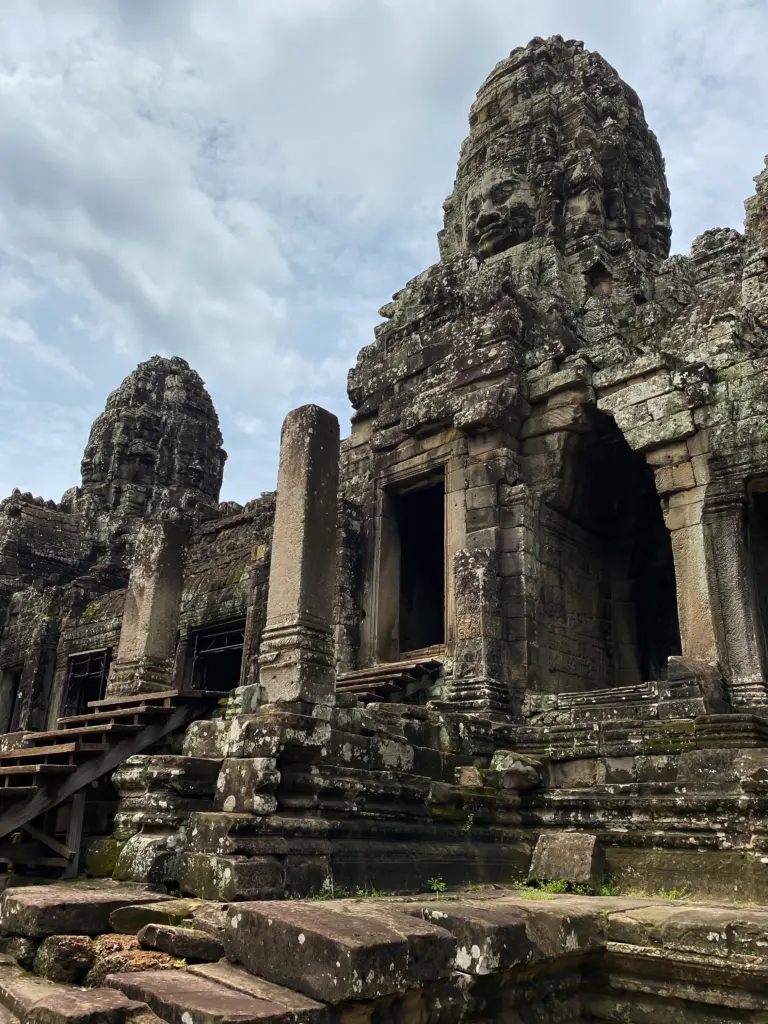
15. Why is the Bayon Temple Important?
Bayon Temple is a symbol of the zenith of the Khmer Empire’s creativity and engineering prowess. The complex design, the intricate bas-reliefs, and those captivating giant faces, all contribute to a unique aesthetic that distinguishes it from other temples in the Angkor region.
Moreover, Bayon Temple plays a crucial role in our understanding of the Khmer Empire’s culture. Its detailed bas-reliefs are much more than decorative carvings. They serve as a visual document, offering us a glimpse into the empire’s socio-political life, religious practices, and even fashion trends of the time.
Not to mention that it’s a site of immense spiritual value. Despite the passage of centuries and the wear and tear of time, the Bayon continues to be a place of worship for locals, you’ll often find monks meditating around the temple.
16. Is Bayon Temple Buddhist or Hindu?
The answer is both! The temple was originally built as a Mahayana Buddhist temple by King Jayavarman VII in the late 12th century. But the intriguing part is that it didn’t stay that way.
After King Jayavarman VII’s reign, his successors reverted back to Hinduism and started altering the temple. The alterations involved changing many of the Buddhist images to Hindu ones. So, the temple, which was initially built to honor the Buddha, later became associated with Hindu deities.
Later, it was then reverted back to Buddhism under the Theravada tradition.
In a nutshell, Bayon Temple has served as both a Buddhist and a Hindu temple over the centuries. It’s an excellent example of the religious syncretism between the two belief traditions.

17. What is Inside Bayon Temple?
As you enter, you’ll find yourself in a maze of narrow corridors and steep stairs, which gradually open up to the temple’s different levels. These passageways can feel a bit like a labyrinth, but that’s part of the adventure!
The inner sanctuary of the temple, located at the center of the top level, was originally home to a statue of Buddha. Over time, this statue was replaced with a linga, a symbol of the Hindu god Shiva, which was part of the temple’s transformation from Buddhist to Hindu.
Of course, the highlight would be the 200+ gigantic faces carved on 54 towers. Each face gazes serenely in the cardinal directions. They are the most iconic feature of Bayon Temple and are a sight to behold.
Let’s not forget about the bas-reliefs. Spread across two levels, they depict historical events and scenes from daily life during the Khmer Empire, with over 11,000 carved figures! From warfare to market scenes, from the grandeur of royal processions to moments of domestic tranquility, you’ll find more details about these further below!
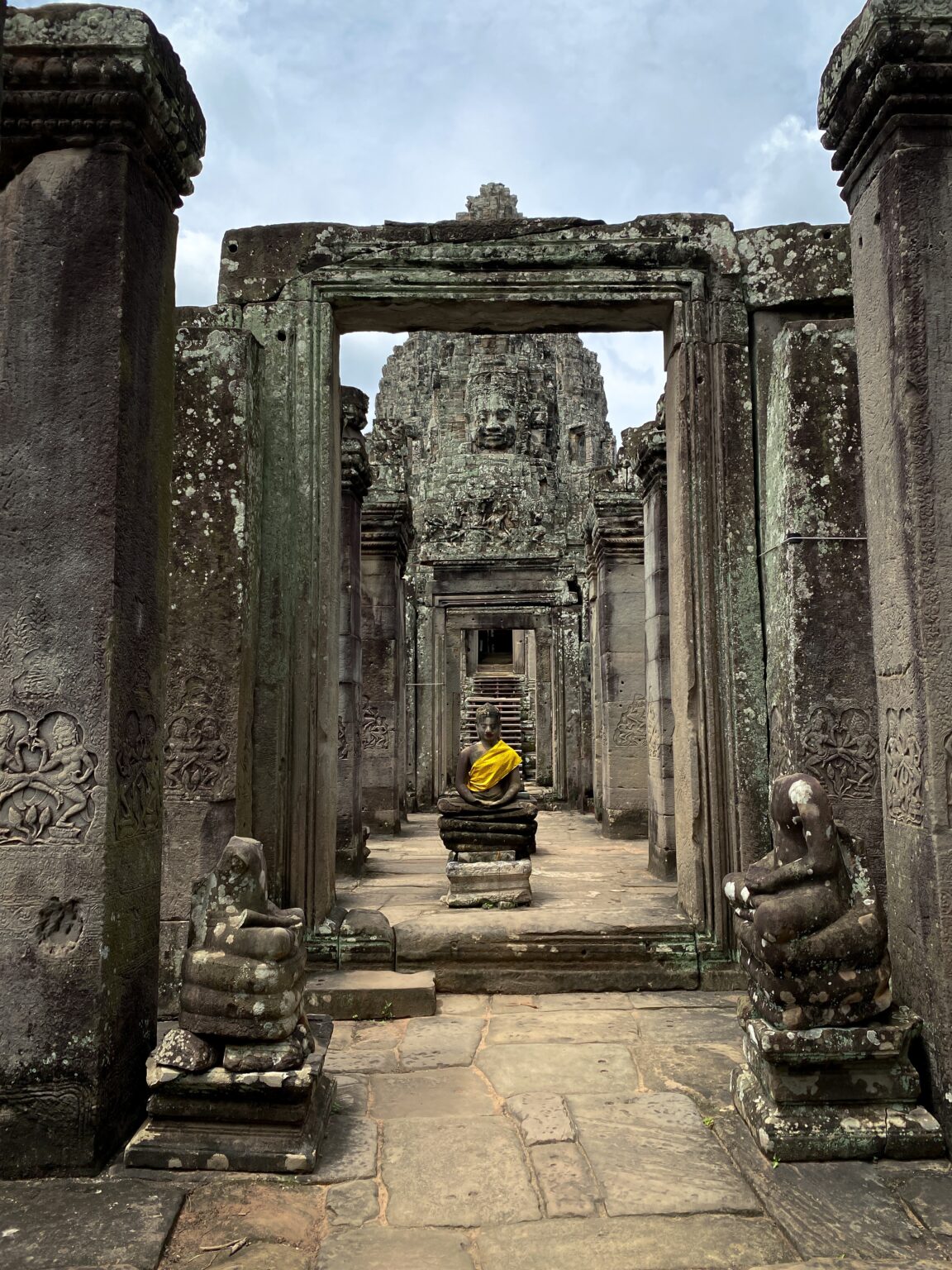
Symbolism of Bayon Temple
18. What Does Bayon Temple Symbolize?
The Bayon is often seen as a representation of the intersection of heaven and earth, a common concept in traditional Khmer architecture.
Bayon Temple also represents the universe. Its central tower is believed to symbolize Mount Meru, considered the center of all physical, metaphysical, and spiritual universes in Hindu and Buddhist cosmologies.
The ocean surrounding Mount Meru is represented by the moats and bodies of water found in the Angkor Thom. While, the outer galleries of the temple, decorated with bas-reliefs depicting scenes from everyday life as well as mythological tales, can be interpreted as the outer world.
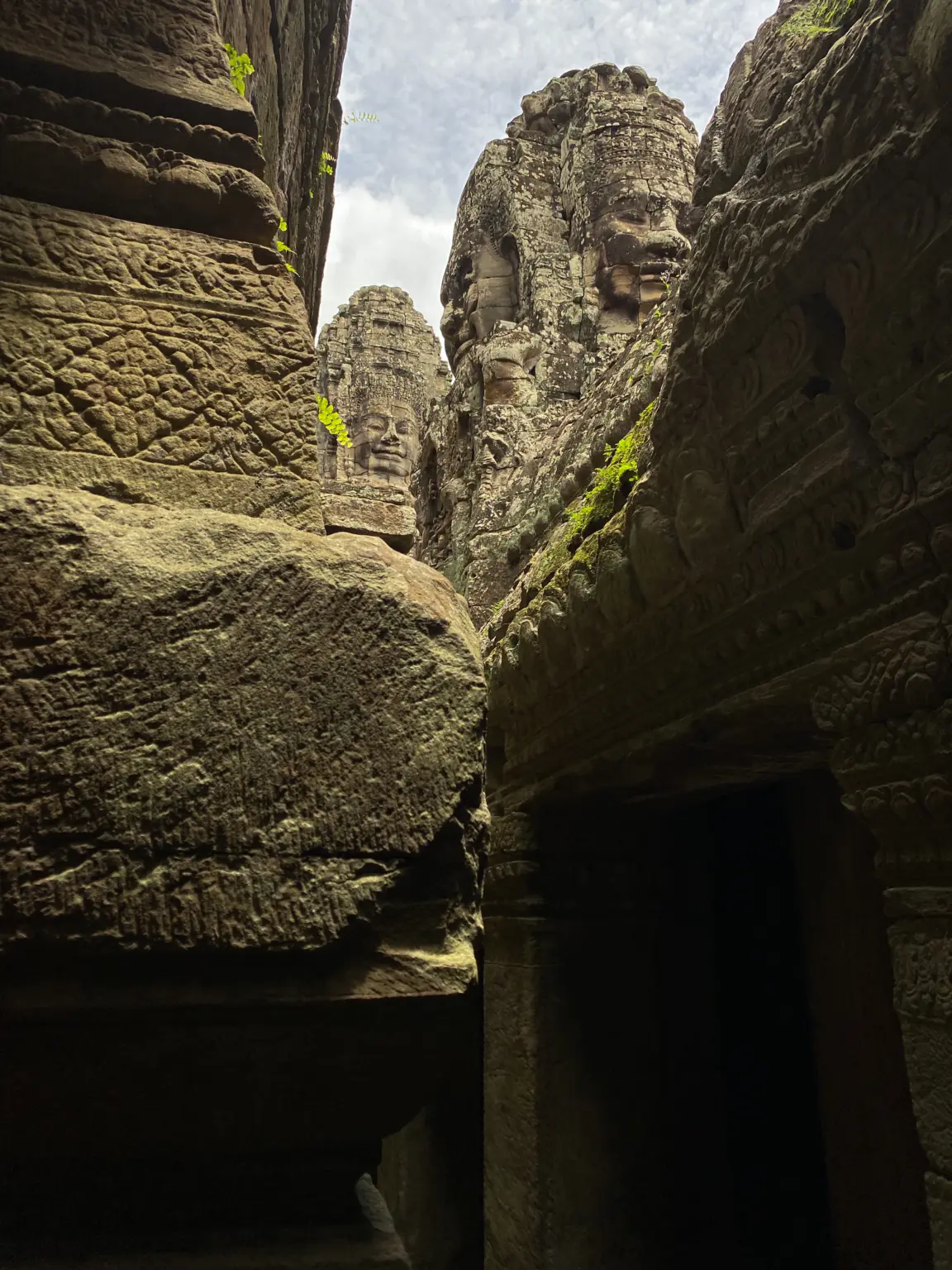
19. What Do the Faces in Bayon Temple Represent?
The captivating faces carved into the stone towers are generally believed to represent Avalokiteshvara, the Bodhisattva of Compassion in Mahayana Buddhism, but with the features of King Jayavarman VII himself.
This aligns with the concept of “devaraja” or “god-king,” suggesting that the king was a divine ruler, essentially the embodiment of Lokeshvara on earth.
There are also other theories that the faces could be the Hindu God of Creation, Brahma as he is often depicted with four faces looking at the four cardinal directions.
20. How Many Faces Does the Bayon Temple have?
The faces of Bayon are spread across 54 towers, and each tower typically has four faces, one looking out in each of the cardinal directions – north, east, south, and west.
So if you do the math, that would originally have been a total of 216 faces!
However, over the centuries, time and natural elements have taken their toll, and not all of the original faces have survived in complete form. Nowadays, there are still around 173 faces that still remain.

21. What Do the Four Faces of Bayon Temple Mean?
In Buddhism, particularly in the Mahayana tradition followed by Jayavarman VII, the four faces of Avalokiteshvara (who the faces are thought to represent) are often associated with the Four Immeasurables. These are virtues to cultivate in order to attain enlightenment.
The Four Immeasurables:
- Loving-kindness (Metta): The wish for all sentient beings to be happy.
- Compassion (Karuna): The desire for all sentient beings to be free from suffering.
- Sympathetic Joy (Mudita): The joy in the happiness and success of others.
- Equanimity (Upekkha): This is a balanced state of mind, undisturbed by extreme emotional states like passion, hatred, and prejudice.
The Four Noble Truths:
- The Truth of Suffering (Dukkha): Recognition that suffering exists in life. This can include physical and emotional pain, as well as the dissatisfaction that comes with unfulfilled desires.
- The Truth of the Cause of Suffering (Samudaya): The second noble truth is the understanding that the origin of suffering is attachment to things that are impermanent.
- The Truth of Cessation of Suffering (Nirodha): The third noble truth is the realization that suffering can be overcome and brought to an end by letting go of attachment.
- The Path to the Cessation of Suffering (Magga): The fourth noble truth is the path that leads to the cessation of suffering. This is called the Noble Eightfold Path, which you can read more about here.

Secrets of Bayon Temple
22. Mount Meru and Bayon Temple
In Hindu cosmology, Mount Meru is believed to be the dwelling place of Lord Brahma and other gods. It’s often described as a magnificent mountain made of gold and precious gems, standing at the center of the universe and reaching breathtaking heights. The sun and all the planets revolve around it.
Buddhist cosmology also holds Mount Meru in high regard. It’s still the center of the universe, but the details differ slightly. In this tradition, Mount Meru is surrounded by a vast ocean and several continents, inhabited by both ordinary humans and deities.
23. Deities of Bayon Temple
-
Avalokiteshvara (Lokeshvara): This Bodhisattva of compassion is represented by the large serene faces on the temple’s towers.
-
Buddha: The original temple housed numerous Buddha images, although many were altered or destroyed over time. The central shrine still primarily features the Buddha.
-
Brahma: Part of the Hindu Trimurti (Trinity), Brahma is the creator God and sometimes the faces are associated with him.
-
Shiva: Another deity in the Trimurti, known as the destroyer and transformer, Shiva’s images are often in the form of the Lingam, a phallic like sculpture.
-
Vishnu: Known as the preserver of the universe and also part of the Trimurti, Vishnu can also be found in Bayon Temple though Angkor Wat is the temple primarily dedicated to him.
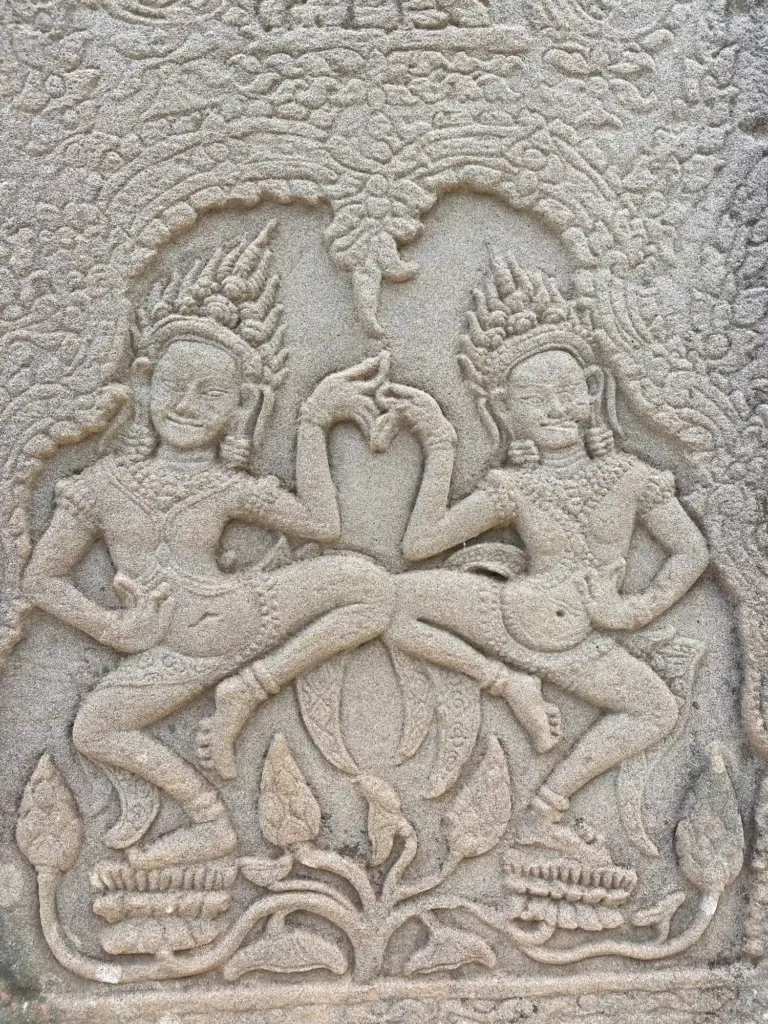

24. Mythical Beings of Bayon Temple
The Bayon Temple is home to a plethora of mythical beings derived from both Hindu and Buddhist mythology. Here are some that you’ll encounter at the Bayon:
Devas: Devas are benevolent celestial beings.
Asuras: Asuras are often regarded as demons. They’re usually depicted in a constant power struggle with the Devas.
Lions: Stone lions are commonly found guarding the entrances to the temple, reinforcing their role as protectors. In Buddhism, the lion is associated with Buddha, who was often referred to as the ‘Lion of the Shakya clan,’ his birth clan.
Garuda: A mythical bird in Hindu and Buddhist mythology, Garuda is considered the mount of Lord Vishnu. You’ll find several carvings of Garuda on the outer gallery of the Bayon.
Naga Serpents: Prominently displayed throughout the Bayon, these multi-headed serpents are often used as balustrades on causeways leading into the temple.
Apsaras: These celestial nymphs are beautifully carved on the walls and towers of the Bayon.
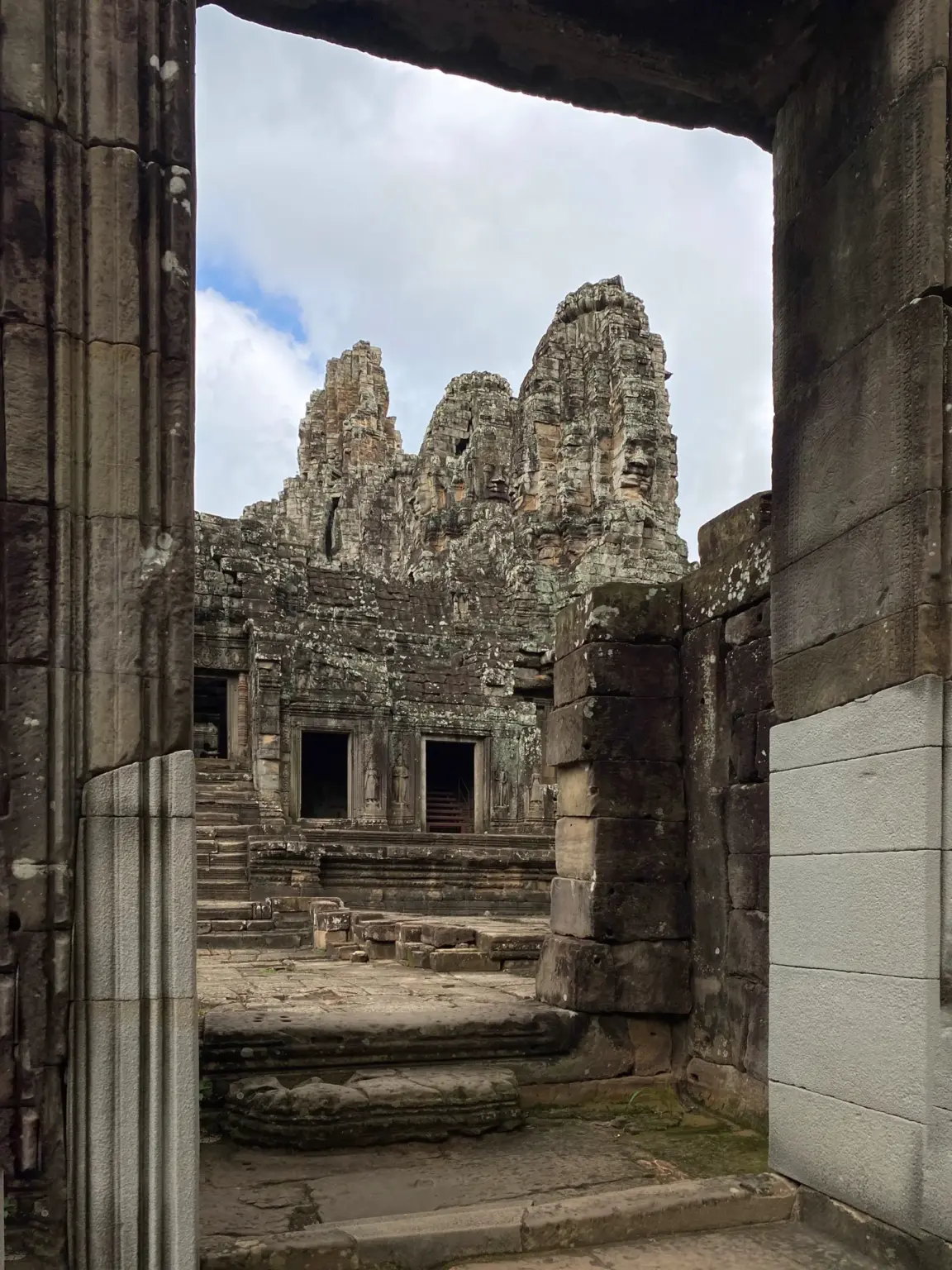
25. Bas-reliefs Depictions in Bayon Temple
While the Angkor Wat had a lot of mythical tales such as the Ramayana, the bas-reliefs in Bayon focus a bit more on the everyday life of the Khmer. Here are just some that you can try to find and recognize:
Khmer Army March: In the southern part of the eastern gallery, complete with a cacophony of musicians, mounted horsemen, and commanding officers atop majestic elephants. Among the army’s ranks, you also find women, possibly the wives of soldiers, and wagons filled with supplies for the journey ahead. Above it all, the King and Queen survey their troops from the royal palanquin.
Naval Battle and Daily Life Scenes: In the eastern part of the southern galery, the scene unfolds over the waters of Tonle Sap, where the Khmer and Cham forces engage in a fierce naval battle. The detail and realism of this relief are astonishing. Below this turbulent scene, everyday life carries on with vignettes of people engaged in various activities, reminding us that amidst the chaos of war, the rhythm of daily life continues.
The Civil War: This section appears unfinished and you can find it in the southern part of the western gallery. Even in its incomplete state, it tells a tale of heated disagreements escalating into violence, with scenes of Khmer warriors locked in bitter combat.
King Retires to the Forest to Celebrate Indrabhisaka: It the nothern part of the western gallery, this shows the King embarking on a spiritual journey into the forest. The King is depicted standing on an elephant, preceding the ark of the sacred flame.
Building of Khmer Temple: In the western portion of the southern gallery, you can find the laborious process of temple construction during the Khmer Empire. Craftsmen can be seen carefully carving and shaping the stones. Above this scene, a large figure, possibly Vishnu, overlooks the proceedings.
Plan Your Trip to Siem Reap | Best Travel Resources
Book Your Accommodations
- Booking.com – the world’s leading online booking platform for accomodations around the world, they have an extensive amount of available listings with zero booking fees and best price guarantees.
- Hostelworld – a backpacker’s best friend, Hostelworld has the largest collection of hostels and guesthouses for affordable prices.
Don’t Forget Insurance
- SafetyWing – from Nomad Insurance, an insurance by nomads for nomads. They understand our lifestyle well and have really comprehensive and flexible plans that cater to any traveler.
Find Cheap Flights
- Kiwi.com – my go-to for booking and finding the cheapest flights and it’s helped me save tons of money. They do virtual interlining which is connecting flights from airlines that do not codeshare, so you can find routes that you wouldn’t be able to find normally.
Join Tours & Activities
- GetYourGuide – is one of the best places to find unique tours and activities. I found that it’s an excellent way to meet fellow travelers and create fond memories. They are not only limited to tours as they also offer niche services such as skip-the-line tickets or private transfers.
Catch a Ride
- Rentalcars.com – nothing beats the freedom of the road, Rentalcars.com is the world’s largest online car rental service. They operate across 160 countries so they’re the perfect partner to work with if you find yourself wanting a ride.

